Short hair doesn’t mean you have to compromise on the versatility and beauty of dreadlocks.
Whether you’re new to the loc journey or looking to refresh your current style, short dreads offer a perfect blend of low maintenance and high fashion that adapts to any lifestyle.
This comprehensive guide explores 30 latest dreadlock styles for short hair that look fresh, covering everything from classic starter locs to bold contemporary twists that make a statement.
You’ll discover styling techniques, maintenance tips, and creative variations that prove short dreadlocks can be just as dynamic and expressive as their longer counterparts.
From professional settings to casual outings, these styles offer endless possibilities for self-expression while celebrating the natural texture and beauty of locked hair.
Get ready to find your next signature look that combines practicality with undeniable style.
Contents
- 1 1. Starter Locs with High Fade
- 2 2. Two-Strand Twist Short Locs
- 3 3. Blonde Short Dreadlocks
- 4 4. Freeform Short Locs
- 5 5. Colored Tips on Short Locs
- 6 6. Short Locs with Temple Fade
- 7 7. Interlocked Short Dreadlocks
- 8 8. Short Locs with Design Shaved Sides
- 9 9. Micro Short Locs
- 10 10. Barrel Twist Short Locs
- 11 11. Natural Black Short Locs
- 12 12. Short Locs with Twist-Out Ends
- 13 13. Short Sisterlocs
- 14 14. Sponge Method Short Locs
- 15 15. Auburn/Burgundy Short Locs
- 16 16. Short Locs with Low Fade
- 17 17. Chunky/Thick Short Locs
- 18 18. Short Locs with Bald Fade
- 19 19. Comb Coil Short Locs
- 20 20. Highlighted Short Locs
- 21 21. Short Locs with Braided Sides
- 22 22. Salt and Pepper Short Locs
- 23 23. Short Locs with Undercut Design
- 24 24. Tapered Short Locs
- 25 25. Honey Blonde Short Locs
- 26 26. Short Locs with Twist Front
- 27 27. Copper Red Short Locs
- 28 28. Short Locs with Mohawk Shape
- 29 29. Short Locs with Defined Parts
- 30 30. Natural Textured Short Locs with Volume
- 31 Maintenance Tips for Short Dreadlocks
- 32 Conclusion
1. Starter Locs with High Fade
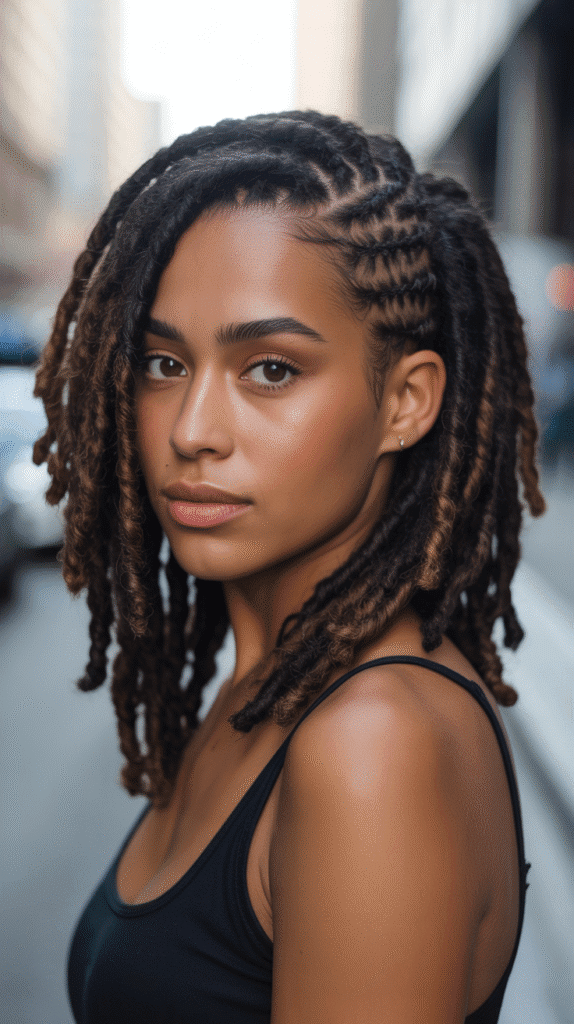
Starter locs combined with a high fade create a clean, modern aesthetic that’s perfect for those beginning their dreadlock journey.
This style offers the best of both worlds—the textured crown of emerging locs with the sharp definition of a professionally faded undercut.
- The high fade draws attention upward, emphasizing the texture and formation of your developing locs while keeping the sides neat and professional.
- This style works exceptionally well for office environments where you want to maintain a polished appearance while embracing natural hair.
- Starter locs typically take 3-6 months to begin locking, and the fade helps maintain shape during this transitional period.
- Regular maintenance every 2-3 weeks keeps the fade crisp and allows your stylist to monitor loc development.
- The contrast between smooth faded sides and textured top creates visual interest that photographs beautifully.
2. Two-Strand Twist Short Locs

Two-strand twists on short locs deliver a defined, rope-like texture that adds dimension and sophistication to your look.
This technique is gentler on hair than palm rolling and creates uniform, cylindrical locs with beautiful spiral patterns.
- Two-strand twisting allows for more controlled loc formation and works particularly well on hair that’s 2-4 inches in length.
- This method reduces frizz and flyaways better than other techniques, giving your locs a neater appearance between maintenance sessions.
- The twisting pattern creates natural elasticity, which means less breakage and healthier locs overall.
- You can achieve this style at home with practice, making it cost-effective compared to other loc methods.
- The defined spiral pattern catches light beautifully, adding depth and movement to your overall look.
3. Blonde Short Dreadlocks
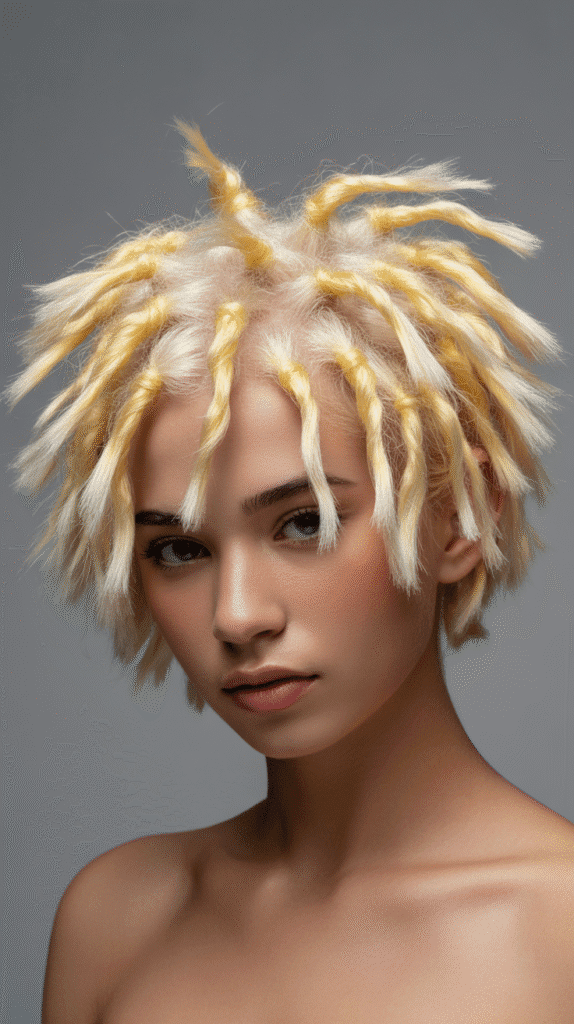
Blonde short dreadlocks make a bold fashion statement that illuminates your features and adds an edgy, contemporary vibe to the traditional loc style.
This color choice transforms classic locs into a high-fashion accessory.
- Bleaching requires professional expertise to maintain loc integrity while achieving your desired blonde shade.
- Blonde locs need extra moisture and protein treatments to counteract the drying effects of bleach.
- This color shows off loc texture and individual strand definition better than darker colors.
- Purple shampoo becomes essential for maintaining cool tones and preventing brassiness in blonde locs.
- The dramatic contrast works beautifully on all skin tones when the right shade of blonde is selected.
4. Freeform Short Locs
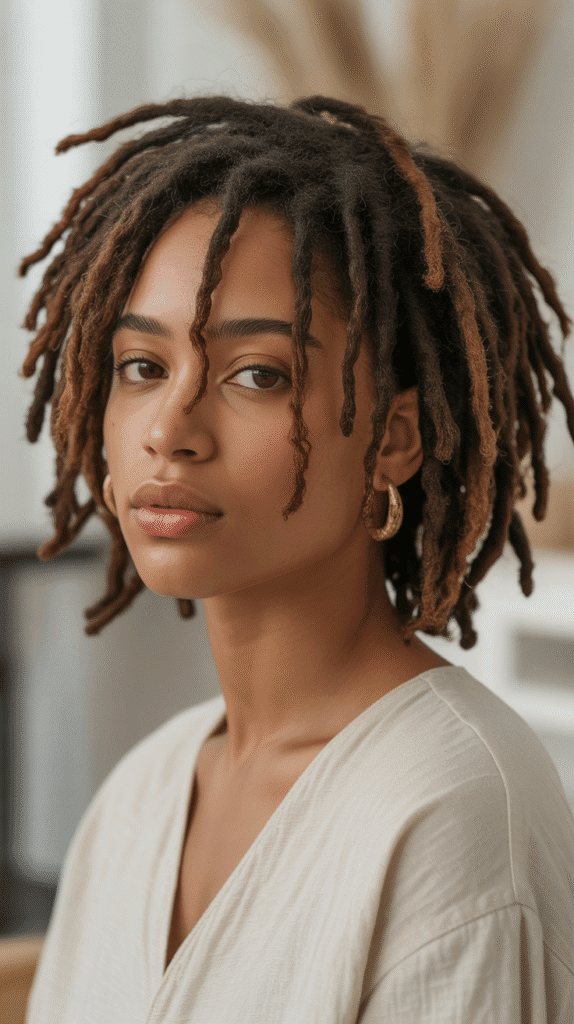
Freeform short locs embrace the organic locking process without manipulation, allowing your hair to loc naturally according to its own pattern.
This approach celebrates individuality and creates truly unique loc formations.
- Freeform locs develop their own size and shape based on your hair’s natural sectioning and movement patterns.
- This method requires minimal maintenance—just regular washing and occasional separation to prevent unwanted congos.
- The unpredictable nature of freeform locs means no two heads will ever look exactly alike.
- Many people choose freeform for spiritual or cultural reasons, viewing it as the most authentic expression of the loc journey.
- Patience is essential, as freeform locs may take longer to mature compared to cultivated methods.
5. Colored Tips on Short Locs

Adding colored tips to short dreadlocks creates a playful, gradient effect that adds personality without fully committing to all-over color.
This style offers creative expression with less maintenance than full-color treatments.
- Dip-dyeing only the ends minimizes chemical damage to the majority of your locs.
- You can experiment with bold colors like blue, purple, or red without professional bleaching if you have naturally lighter hair.
- This technique allows for easy color changes—simply cut off the colored portion when you’re ready for something new.
- Colored tips draw the eye and create movement, making short locs appear more dynamic.
- Semi-permanent dyes work well for this technique and fade gradually for a lived-in look.
6. Short Locs with Temple Fade
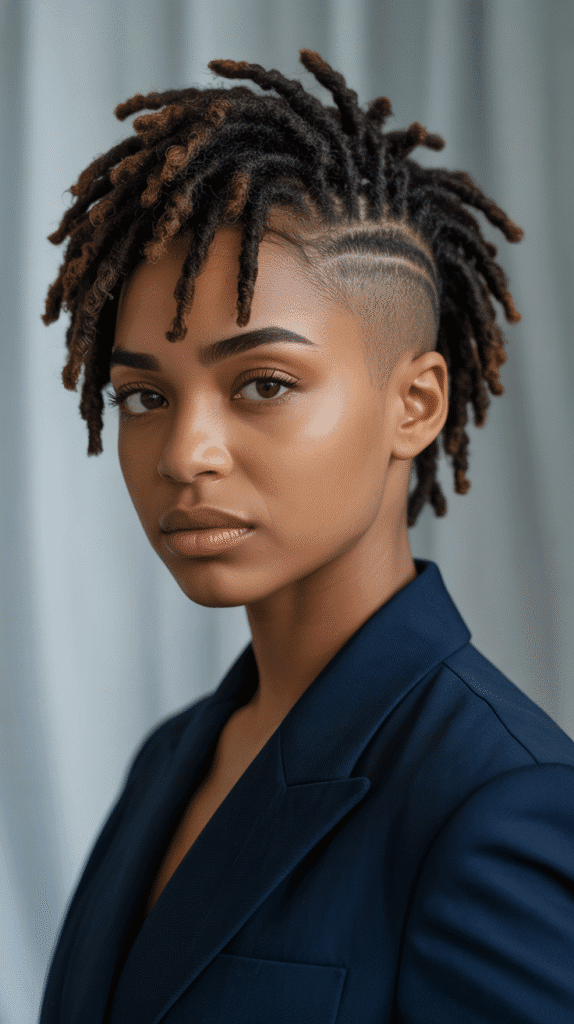
The temple fade adds subtle definition around the hairline while keeping the crown full of textured locs.
This refined approach creates a balanced silhouette that frames the face perfectly.
- Temple fades provide just enough contrast without the dramatic effect of a full high fade.
- This style works particularly well for those with naturally strong jawlines or angular facial features.
- The gradual fade creates a softer transition that’s appropriate for conservative work environments.
- Regular touch-ups every 3-4 weeks maintain the fade’s definition and clean lines.
- This versatile style transitions seamlessly from professional settings to casual weekend activities.
7. Interlocked Short Dreadlocks
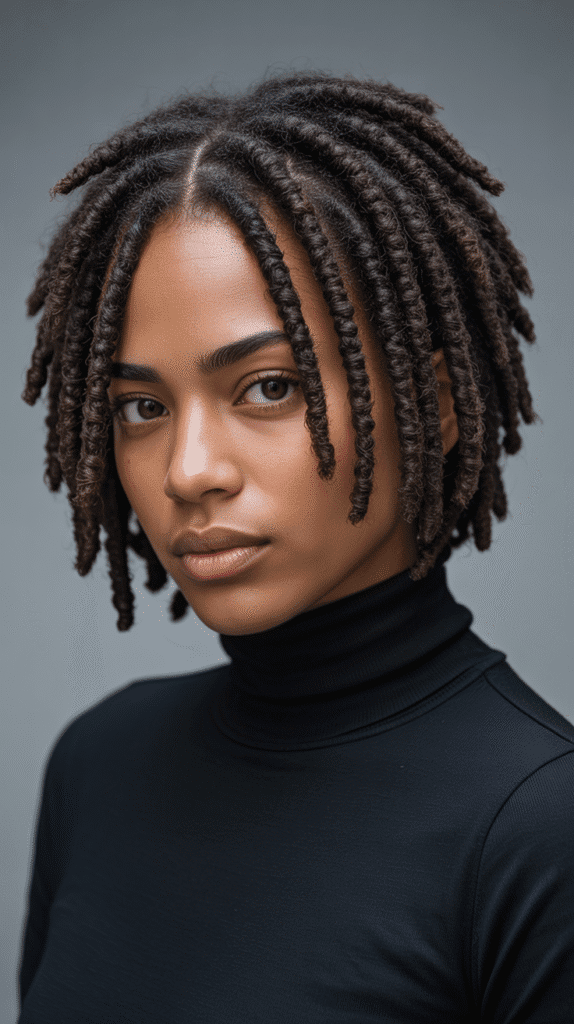
Interlocking creates tight, neat locs by pulling the end of the loc through the root using a specialized tool.
This method produces extremely uniform locs with minimal frizz.
- Interlocking works exceptionally well on fine or straight hair textures that struggle to loc using other methods.
- This technique creates the neatest, most uniform locs of any method, ideal for those who prefer a polished appearance.
- Maintenance sessions are needed every 4-8 weeks depending on hair growth rate.
- Over-interlocking can cause thinning, so it’s crucial to work with an experienced loctician who understands proper tension.
- The structured appearance of interlocked locs photographs beautifully and maintains its shape in all weather conditions.
8. Short Locs with Design Shaved Sides

Combining short locs with artistic designs shaved into the sides creates a striking contrast between organic texture and precise geometric patterns.
This style showcases both natural beauty and artistic expression.
- Shaved designs can be customized to reflect personal style, cultural heritage, or artistic preferences.
- The designs typically last 1-2 weeks before needing touch-ups as hair grows out.
- This bold style makes a statement and works well for creative professionals and artists.
- Simple designs like lines or waves are easier to maintain than intricate patterns.
- The contrast between soft locs and sharp designs creates visual drama that turns heads.
9. Micro Short Locs

Micro locs are exceptionally thin dreadlocks that create a delicate, refined look with incredible versatility.
Despite their small size, these locs pack serious style impact.
- Micro locs typically range from 1/8 to 1/4 inch in diameter, allowing for hundreds of individual locs.
- The installation process is time-intensive, often taking 12-24 hours depending on hair density and length.
- These thin locs offer maximum styling flexibility—you can create intricate updos even with short length.
- Micro locs put less tension on individual hair follicles, potentially reducing traction alopecia risk.
- The delicate appearance appeals to those who want locs but prefer a more subtle, feminine aesthetic.
10. Barrel Twist Short Locs
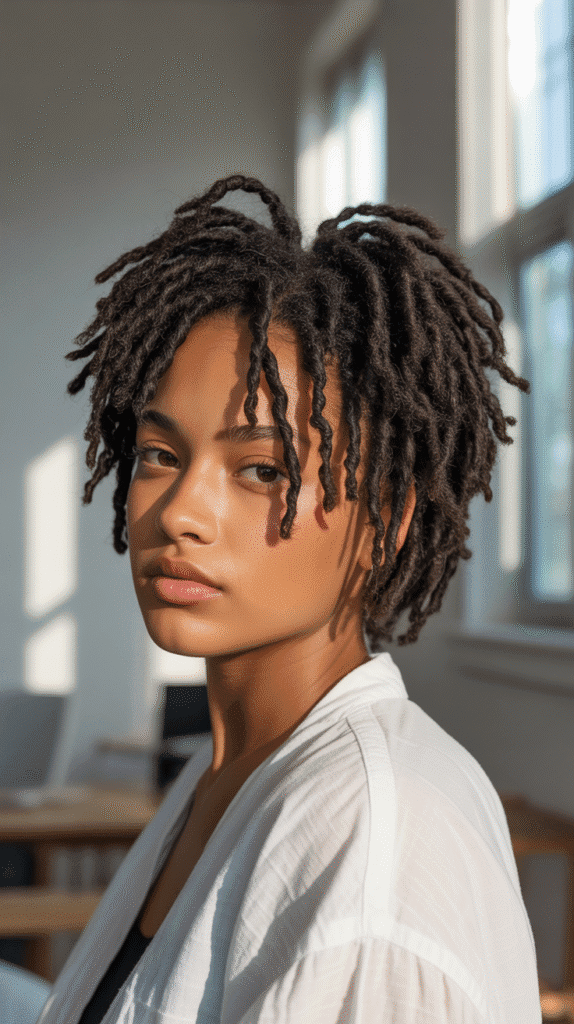
Barrel twists create chunky, cylindrical locs with a distinct coiled appearance that offers bold texture and visual weight.
This style makes short locs appear fuller and more substantial.
- Barrel twists work best on hair that’s at least 3-4 inches long for proper hold and definition.
- This technique creates locs with more volume than traditional palm rolling or two-strand twisting.
- The chunky appearance suits those who want a more dramatic, fashion-forward loc style.
- Maintenance involves retwisting the roots while preserving the barrel shape down the length.
- These substantial locs have a satisfying weight and movement that feels distinctly different from thinner loc styles.
11. Natural Black Short Locs

Classic natural black short locs celebrate hair in its authentic state without color treatments or excessive manipulation.
This timeless style emphasizes texture, health, and natural beauty.
- Natural black locs require less maintenance than colored styles, allowing you to focus on loc health and growth.
- The dark color showcases natural shine and highlights the health of well-moisturized locs.
- This versatile style works in any setting, from corporate offices to creative spaces.
- Without chemical treatments, your locs maintain maximum strength and resilience.
- Natural black is the most cost-effective option, eliminating ongoing color maintenance expenses.
12. Short Locs with Twist-Out Ends
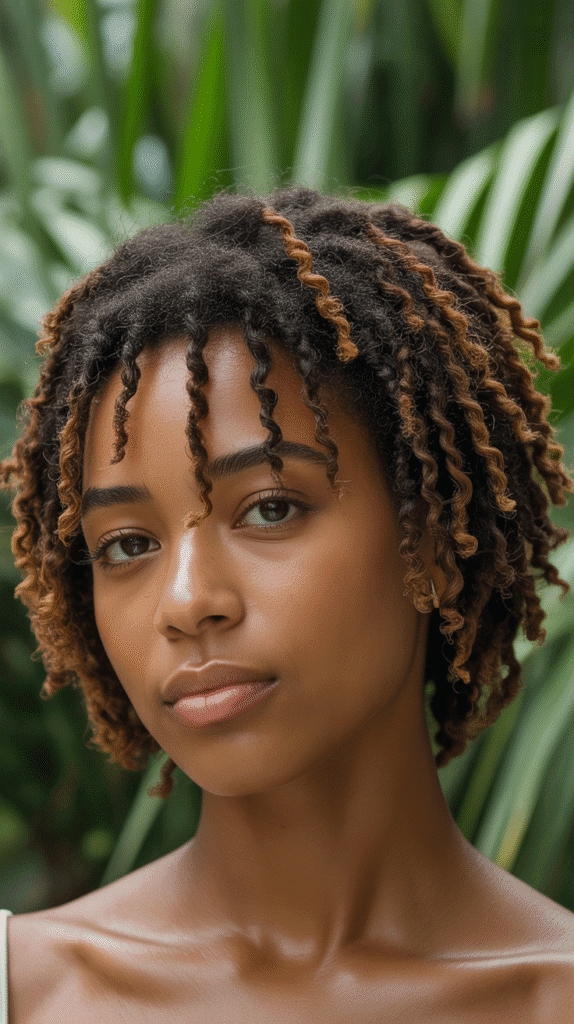
Leaving the ends of short locs unloced and styled with a twist-out creates a playful textured finish that softens the overall look.
This combination style offers the best of locs and loose natural hair.
- Twist-out ends add movement and softness to the structured appearance of locs.
- This style works well during the early stages of the loc journey when ends haven’t fully matured.
- The textured ends create a feminine, romantic aesthetic that balances the boldness of locs.
- You can refresh the twist-out between loc maintenance appointments for variety.
- This approach allows you to embrace the locking process gradually without rushing the ends.
13. Short Sisterlocs
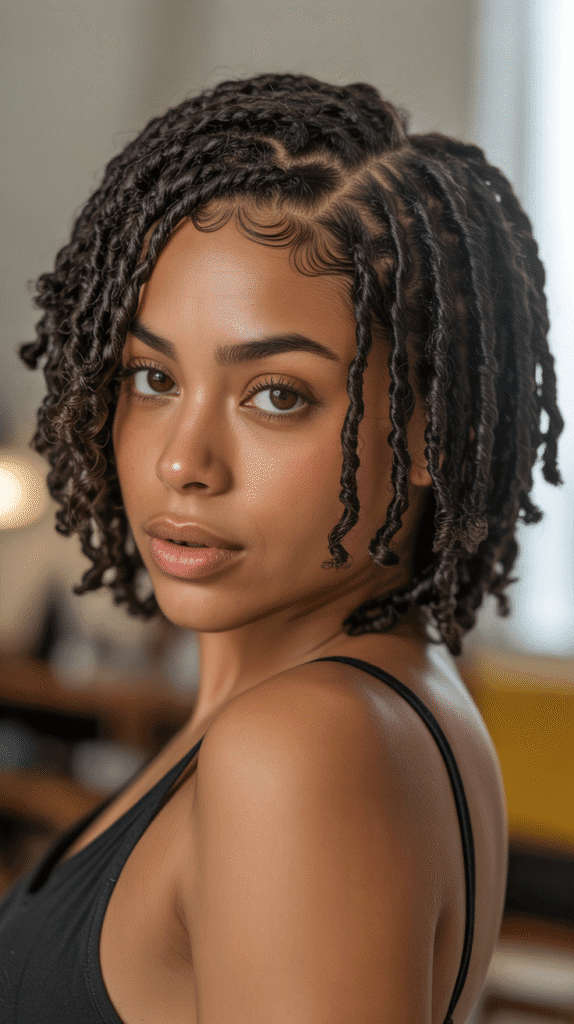
Sisterlocs are a trademarked technique creating extremely small, uniform locs using a specialized tool.
This precision method produces hundreds of delicate locs that mimic loose hair versatility.
- Sisterlocs must be installed by a certified consultant who has completed specific training in the technique.
- The micro-sizing allows for virtually any hairstyle—curls, updos, and even the appearance of loose hair.
- Installation takes 12-36 hours depending on hair length, density, and texture.
- Maintenance appointments are needed every 4-6 weeks to retighten new growth.
- This investment-level style offers unparalleled versatility and a polished, refined appearance.
14. Sponge Method Short Locs
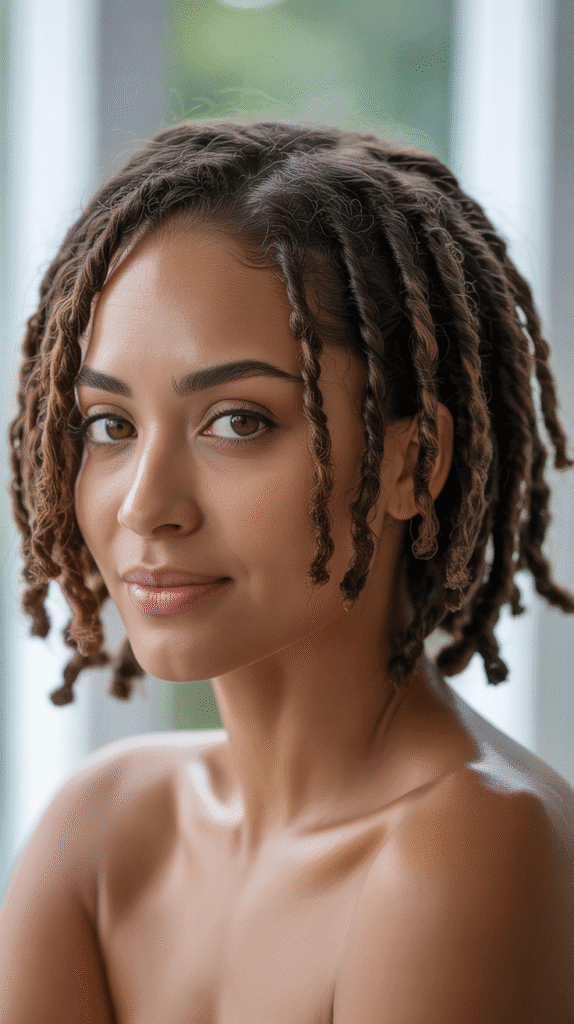
The sponge method uses a specialized curl sponge to create uniform, coiled locs quickly and efficiently.
This DIY-friendly technique is perfect for beginners with short natural hair.
- This method works best on natural hair that’s 1-3 inches long with a coily or kinky texture.
- Circular motions with the sponge encourage hair to coil into uniform sections that will eventually loc.
- The technique is one of the fastest ways to start locs, taking just 10-30 minutes.
- Sponge method locs require regular maintenance and retwisting as they mature.
- This affordable starter method costs significantly less than professional loc installation.
15. Auburn/Burgundy Short Locs
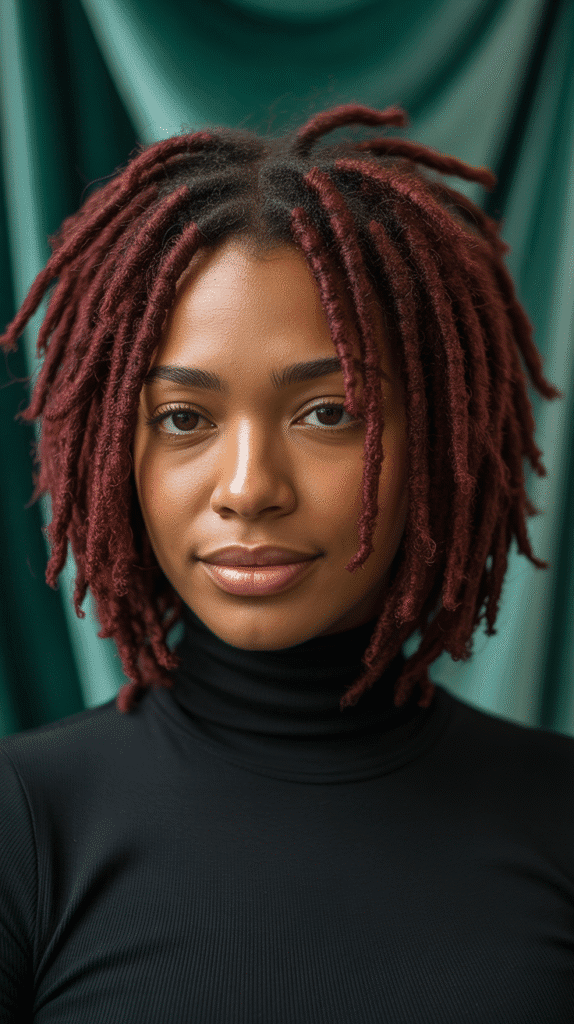
Auburn or burgundy tones add warmth and dimension to short locs, creating a sophisticated, rich color that complements most skin tones beautifully.
These jewel tones elevate locs to luxury status.
- These warm tones work particularly well on medium to dark skin tones, creating beautiful contrast.
- Semi-permanent dyes can achieve these colors without harsh bleaching on naturally dark hair.
- The multidimensional quality of auburn and burgundy adds depth that makes locs appear fuller.
- Regular color-depositing treatments maintain vibrancy between professional coloring sessions.
- These sophisticated colors transition easily from professional daytime settings to evening social events.
16. Short Locs with Low Fade
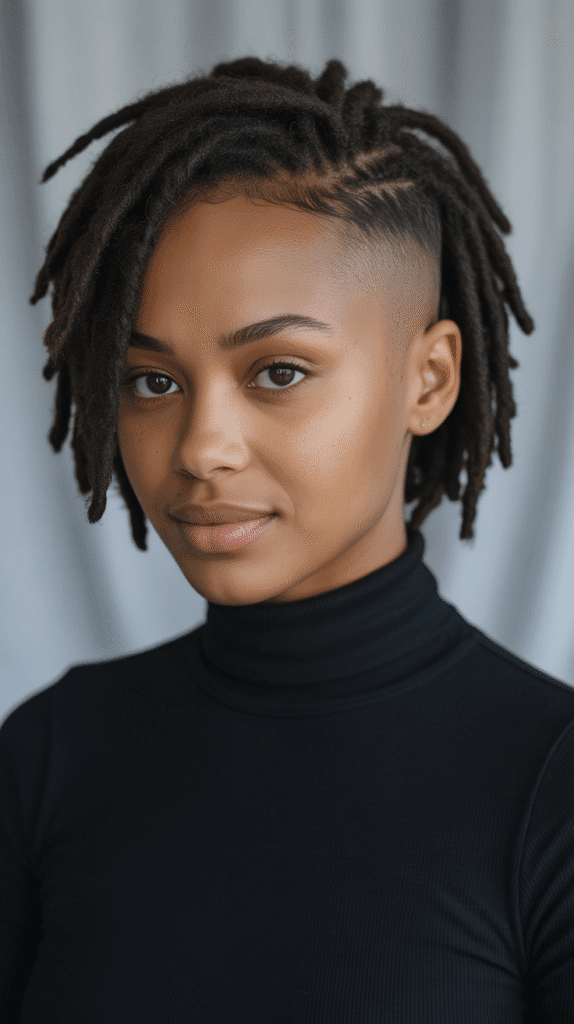
A low fade keeps more length on the sides while still creating definition and shape around short locs.
This conservative approach to fading works well for those who want subtle enhancement.
- Low fades provide a polished look without the dramatic contrast of high fades.
- This style requires less frequent maintenance than higher fades, typically every 3-4 weeks.
- The graduated blend creates a natural-looking transition that doesn’t draw excessive attention.
- Low fades work well in conservative professional environments where extreme styles aren’t appropriate.
- This approach preserves more protective coverage while still offering modern style elements.
17. Chunky/Thick Short Locs
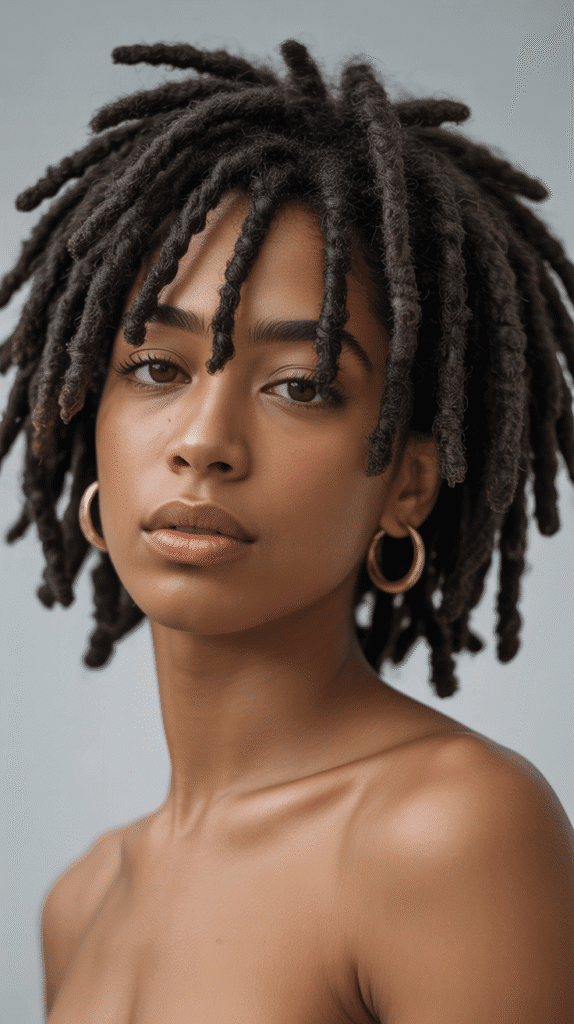
Thick, substantial locs make a bold statement and create the appearance of fuller, more voluminous hair.
These chunky locs have commanding presence and require less individual loc maintenance.
- Thicker locs mean fewer individual locs to maintain, reducing maintenance time and cost.
- This style works well for those with thick, dense hair who want to preserve volume.
- Chunky locs create a more casual, bohemian aesthetic compared to uniform thin locs.
- The substantial weight and movement of thick locs creates satisfying texture and presence.
- Fewer locs mean less tension on the scalp, potentially reducing discomfort during the locking process.
18. Short Locs with Bald Fade
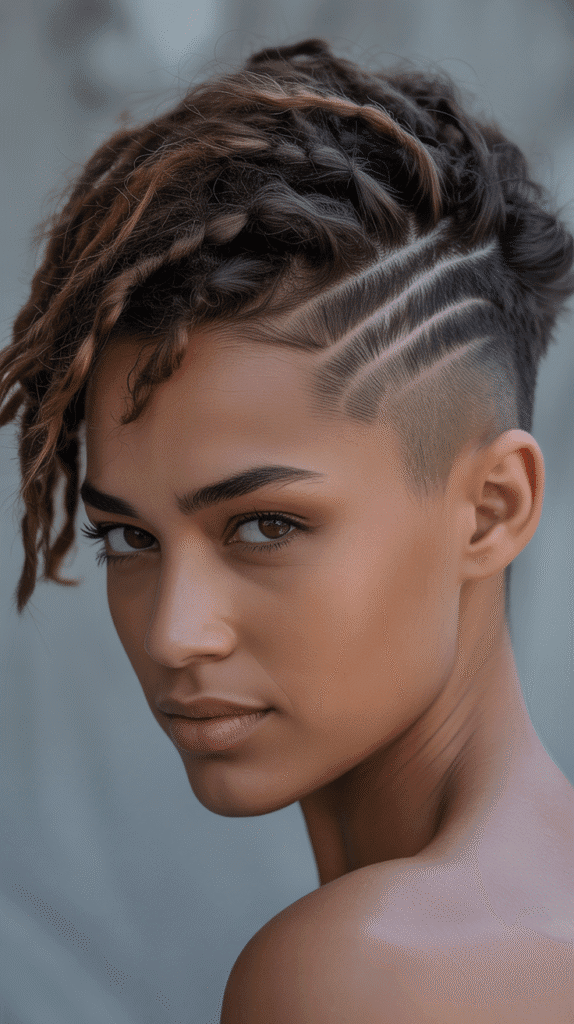
A bald fade creates maximum contrast by taking the sides down to the skin, making short locs on top the undeniable focal point.
This bold style exudes confidence and modern edge.
- Bald fades require the most frequent maintenance, typically every 1-2 weeks to maintain crispness.
- This dramatic style works best for those comfortable with bold, attention-getting looks.
- The extreme contrast showcases the texture and formation of your locs beautifully.
- Professional barbering skill is essential to achieve clean, even bald fades without irritation.
- This style reads as fashion-forward and works particularly well in creative industries.
19. Comb Coil Short Locs

Comb coiling creates spiral locs by twisting small sections of hair with a rattail comb.
This technique produces uniform, spring-like locs with beautiful definition.
- Comb coiling works best on natural hair with at least 2-3 inches of length.
- This method creates some of the most uniform starter locs with consistent size and shape.
- The technique can be time-consuming but produces excellent results that loc reliably.
- Comb coils require patience—avoid touching or manipulating them excessively during the first weeks.
- This starter method tends to produce cylindrical, rope-like mature locs with beautiful uniformity.
20. Highlighted Short Locs
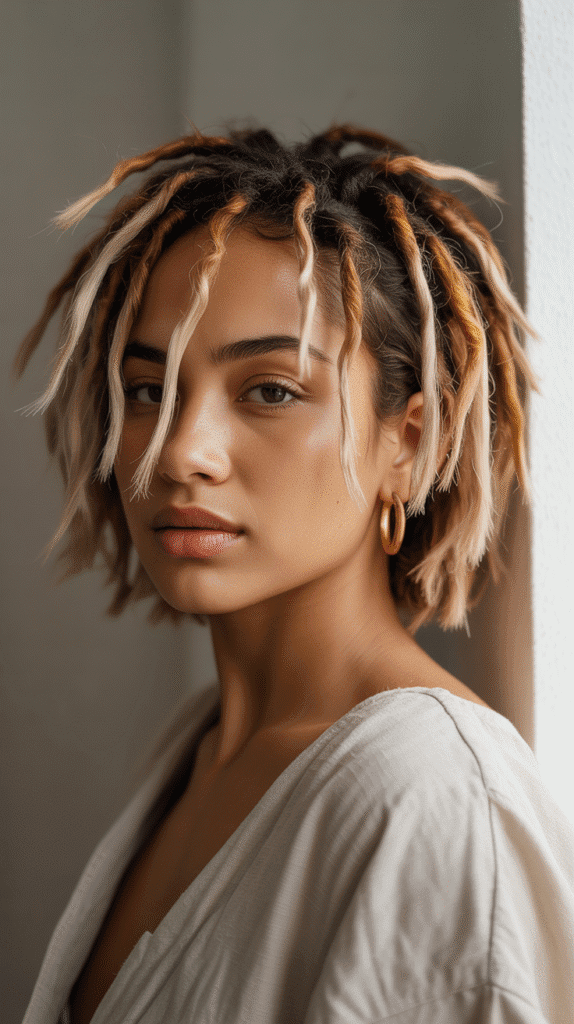
Strategic highlights add dimension and movement to short locs without full color commitment.
Lightened sections create depth that makes locs appear more dynamic and multidimensional.
- Highlights work particularly well on natural black or brown locs, adding warmth and visual interest.
- Foiling or balayage techniques can create natural-looking dimension that mimics sun-lightened hair.
- Strategic placement of highlights can frame the face and accentuate facial features.
- Highlighted locs require less maintenance than all-over color while still providing impact.
- The contrast between natural and lightened locs creates texture and movement in photos.
21. Short Locs with Braided Sides
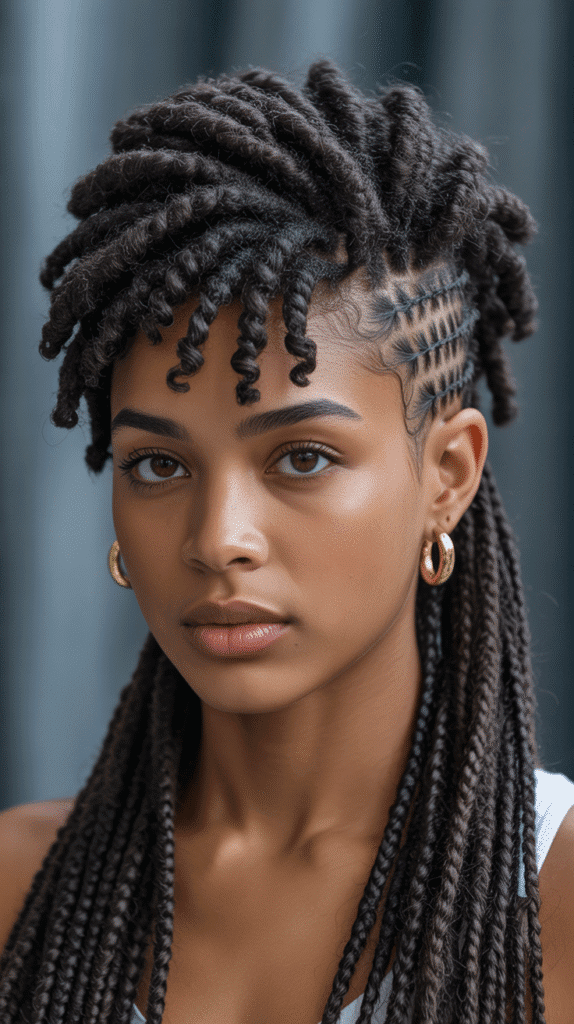
Combining cornrows or braids on the sides with free locs on top creates an intricate, textured style that showcases multiple natural hair techniques.
This fusion approach offers creative complexity.
- Braided sides keep hair flat and controlled while allowing locs on top to remain three-dimensional.
- This style works well for athletic activities, keeping hair secure without sacrificing style.
- The braided sections typically last 2-4 weeks before needing redoing, depending on hair growth.
- This technique is particularly popular in contemporary urban and hip-hop influenced styling.
- The combination of techniques creates visual interest that photographs beautifully from all angles.
22. Salt and Pepper Short Locs

Embracing natural gray and silver locs creates a distinguished, sophisticated look that celebrates aging gracefully.
This natural color story exudes wisdom and confidence.
- Natural gray locs have a unique texture that often appears more wiry and may loc differently than pigmented hair.
- The mixed coloring creates automatic dimension without any artificial processing.
- Gray locs tend to be more fragile and require extra moisture and gentle handling.
- This authentic approach resonates particularly well in professional and mature style contexts.
- The silver tones can be enhanced with purple-tinted products that add shine and reduce yellowing.
23. Short Locs with Undercut Design
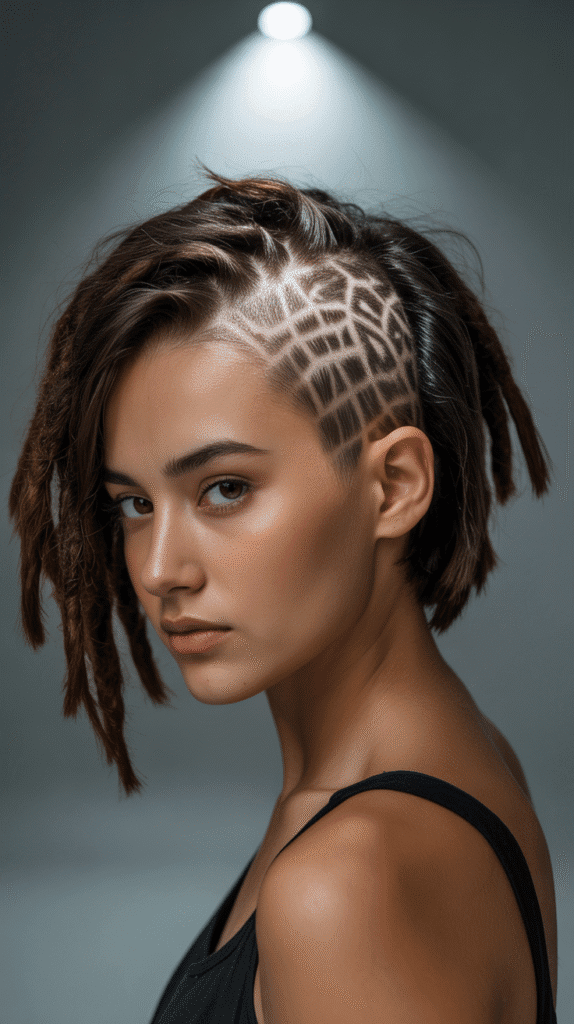
An undercut with artistic designs hidden beneath longer locs on top creates a surprise element—conservative when down, bold when pulled back.
This style offers dual personality.
- Undercut designs remain hidden during professional settings but can be revealed for social occasions.
- This approach offers maximum versatility for those who navigate between different social contexts.
- The shaved area provides cooling relief, particularly beneficial in hot climates.
- Designs can be changed regularly since they’re hidden most of the time.
- This style works particularly well for those with thick, dense hair that benefits from reduced bulk.
24. Tapered Short Locs
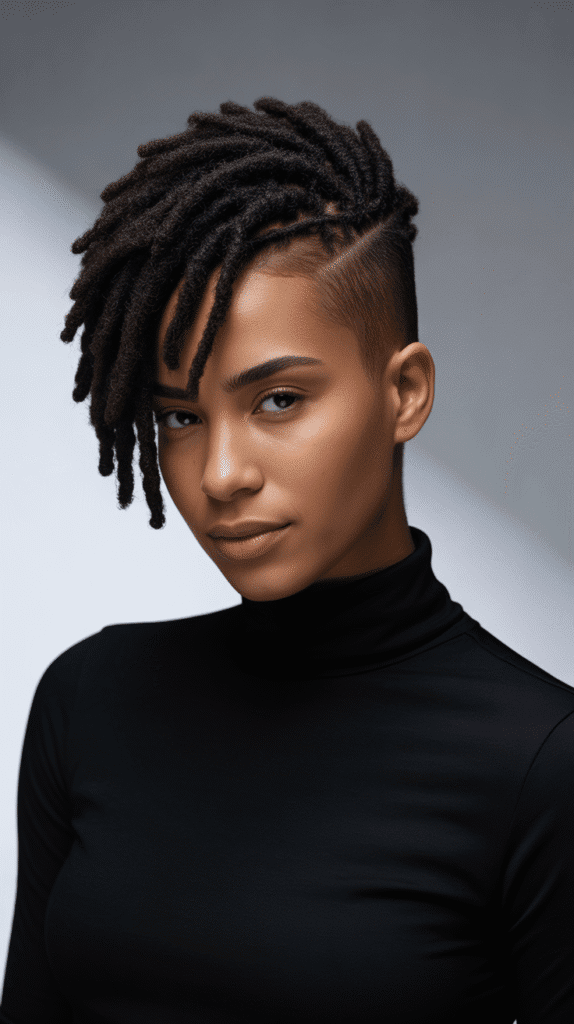
Tapering gradually reduces length from top to bottom, creating a pyramidal silhouette that’s both classic and contemporary.
This shaping technique adds architectural structure to short locs.
- Tapering creates a clean, shaped appearance without the starkness of fades.
- This technique works well for those transitioning from traditional haircuts to locs.
- The graduated length adds sophistication and works particularly well in business-professional settings.
- Regular trims maintain the taper shape as locs grow and mature.
- This universal style flatters most face shapes and head structures.
25. Honey Blonde Short Locs
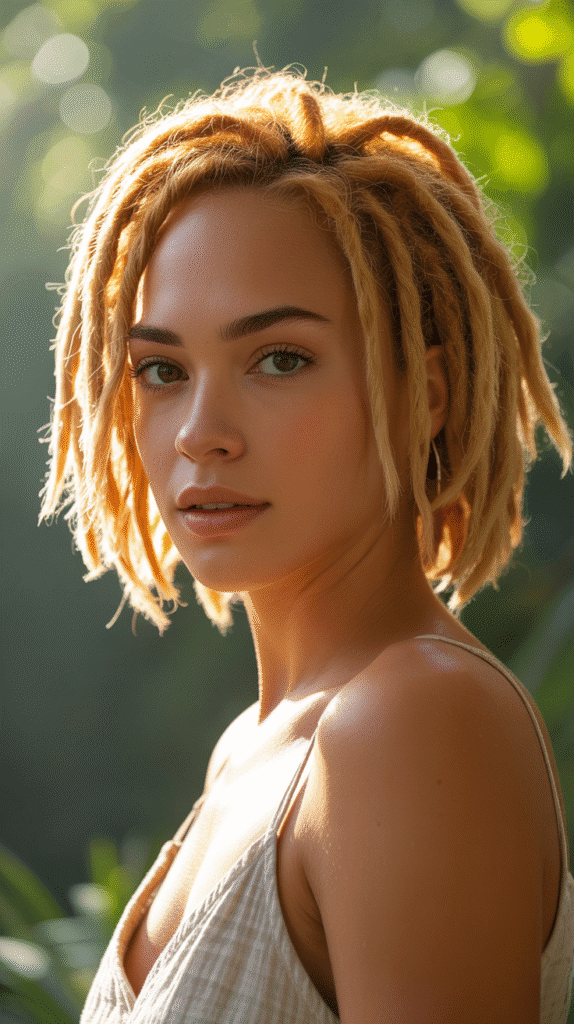
Honey blonde brings warm, golden tones to short locs that radiate light and create a glowing, sun-kissed appearance.
This color choice feels optimistic and attention-getting.
- Honey blonde works beautifully on warm and neutral skin undertones, creating harmonious contrast.
- Achieving this color on naturally dark hair requires professional bleaching and toning.
- The warm undertones prevent the brassy, orange tones that can plague blonde color treatments.
- Regular toning treatments maintain the honey quality and prevent color from becoming dull.
- This vibrant color showcases loc texture and individual strands beautifully in all lighting.
26. Short Locs with Twist Front
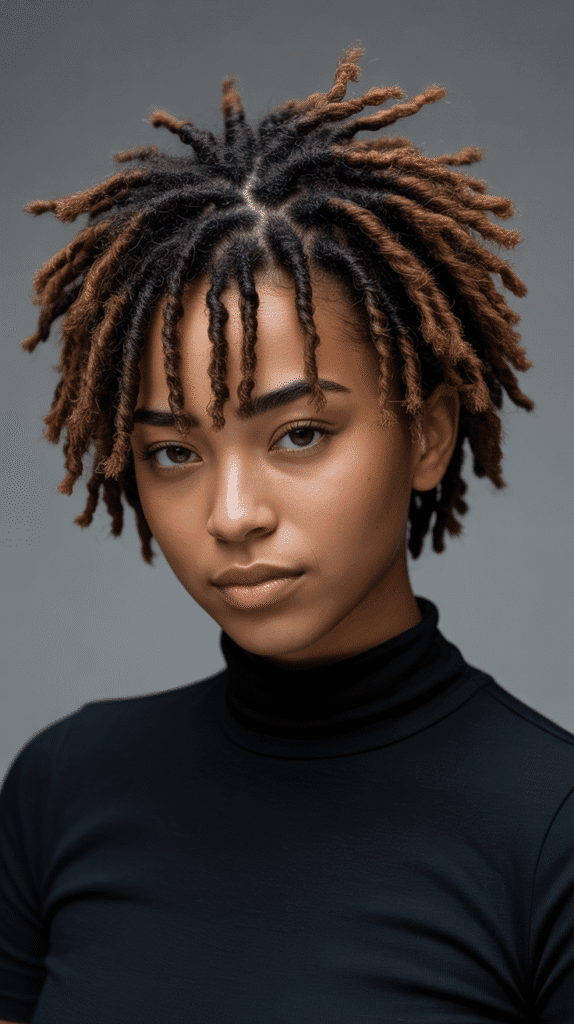
Keeping the front section twisted while the back locs naturally creates an interesting textural contrast that adds dimension.
This styling variation offers easy customization.
- The twisted front section can be refreshed weekly between full maintenance appointments.
- This technique creates a polished hairline while allowing the rest of the locs to mature naturally.
- The contrast in texture adds visual interest and makes the style appear more intentionally crafted.
- Front twists help control baby hairs and create a neater appearance without heavy product use.
- This approach works particularly well during the awkward middle stages of the loc journey.
27. Copper Red Short Locs

Vibrant copper red tones make a fiery, confident statement that demands attention.
This bold color choice transforms short locs into a fashion-forward accessory.
- Copper tones contain both red and orange pigments, creating a unique, multidimensional color.
- This bold choice works particularly well on medium to deep skin tones with warm undertones.
- Red pigments fade faster than other colors, requiring more frequent color maintenance.
- Color-depositing conditioners help extend vibrancy between professional color treatments.
- The dramatic nature of copper red signals confidence and creative self-expression.
28. Short Locs with Mohawk Shape

Styling short locs into a mohawk formation creates punk-influenced edge while maintaining the organic beauty of locked hair.
This bold shape makes an unmistakable statement.
- True mohawks have completely shaved sides, while faux-hawks maintain some length for a softer approach.
- The raised center section can be achieved through cutting or by styling locs upward with product.
- This rebellious style works particularly well for creative professionals and artists.
- The mohawk shape elongates the face and draws attention to facial features.
- Regular maintenance of the shaved sections is essential to preserve the dramatic contrast.
29. Short Locs with Defined Parts
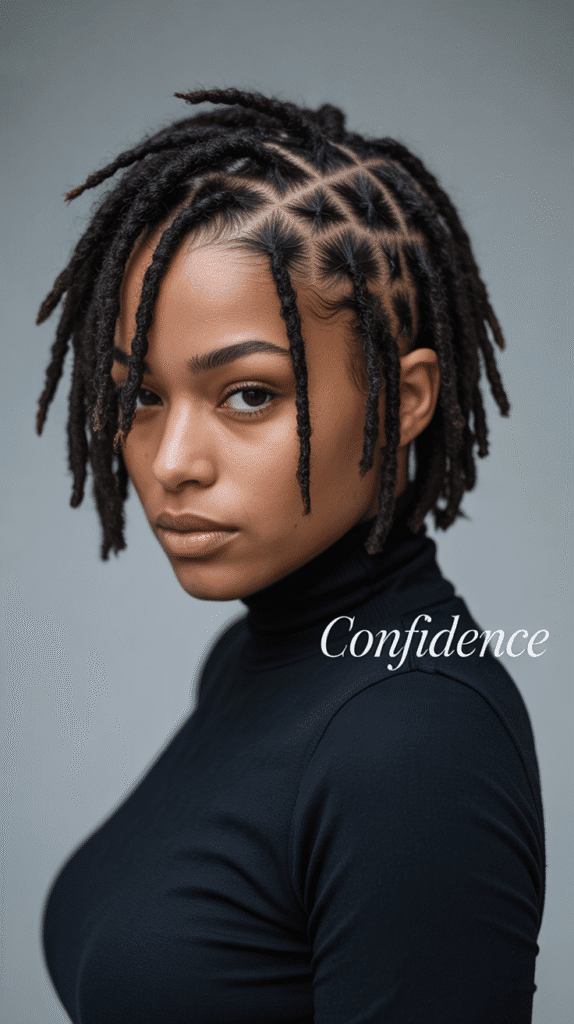
Creating visible, geometric parts between locs adds intentional structure and showcases the scalp as part of the overall design.
This precise approach emphasizes craftsmanship.
- Defined parts can be straight, curved, or angular depending on desired aesthetic.
- Clean parting requires regular maintenance to prevent locs from congaing across part lines.
- This structured approach reads as polished and intentional, ideal for professional settings.
- The visible scalp should be kept moisturized and healthy as it’s part of the overall presentation.
- Geometric parting creates photogenic patterns that look stunning from above.
30. Natural Textured Short Locs with Volume

Embracing maximum texture and volume creates an organic, free-spirited aesthetic that celebrates natural hair in its fullest expression.
This approach prioritizes hair health and authentic beauty.
- This style works with your hair’s natural tendency rather than fighting against it.
- Volume-enhancing techniques include proper moisture balance and avoiding heavy products that weigh locs down.
- The textured appearance creates movement and life, making locs appear dynamic rather than static.
- This approach requires less manipulation, which typically results in healthier, faster-growing locs.
- Embracing natural texture means accepting and celebrating the unique characteristics of your individual locs.
Maintenance Tips for Short Dreadlocks
- Consistent washing prevents buildup that can slow the locking process and cause odor.
- Avoid heavy waxes and products that create residue, which can prevent locs from forming properly.
- Protect locs at night with a satin or silk bonnet or pillowcase to reduce frizz and friction.
- Be patient with the locking process—short locs typically take 6-12 months to fully mature.
- Stay hydrated and maintain a healthy diet, as hair health reflects overall wellness.
- Trim loose ends occasionally if desired, but understand that some frizz is normal and healthy.
- Consider the expertise level needed for your chosen style—some techniques require professional locticians.
Conclusion
The versatility of 30 latest dreadlock styles for short hair that look fresh proves that length limitations don’t restrict creative expression or style possibilities.
From the precision of interlocked locs to the organic beauty of freeform methods, from subtle temple fades to bold colored statements, short dreadlocks offer something for every personality and lifestyle.
The key to rocking short locs successfully lies in choosing a style that aligns with your maintenance commitment, professional requirements, and personal aesthetic while prioritizing hair health throughout your journey.
Whether you’re starting fresh with the sponge method or elevating existing locs with color and fades, these 30 styles demonstrate that short dreadlocks are anything but limiting.
Embrace the journey, trust the process, and remember that every loc tells a unique story of patience, self-expression, and natural beauty.
Your perfect style awaits—now you have the inspiration and knowledge to make it your own reality.
